BEE REMOVALS
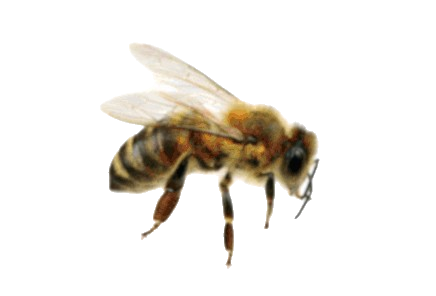
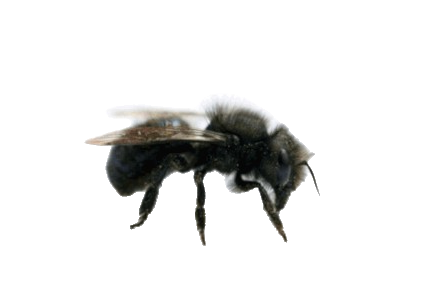
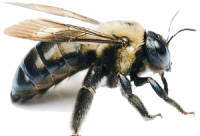
CARPENTER BEES
This removal is live removal and deterrent process. This includes moving bees to a different location and blocking the nesting site access.
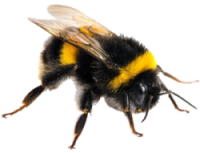
BUMBLE BEES
This service involves digging to the nest site, vacuuming returning foragers, and nest removal (live).
There are 5 types of honey bee removals. Pricing will vary depending on the need for outside equipment, specialty services, or additional material costs. All honey bee removals (other than hanging swarms) start at $950. Hanging swarm removal costs are between $75 - $150, depending on difficulty of the retrieval. Additional costs can include lift or scaffolding rental, stone/brick removal/repair, specialty carpentry, etc.
INSIDE BUILDINGS
A colony can be as large as 50,000+ bees or as small as 20,000 bees. Typically, we find them somewhere in between these numbers. Most are reachable with a ladder. This removal includes the following:
-
- Locating the exact area of the house the colony is residing
- Providing a method to keep the honey bees from entering other areas of the home
- Removing drywall to access the colony
- Live removal of the bees, and all their comb and hive materials
- Bee-proofing the hive location
- Replacing the original drywall and other boards or decor
- Moving the colony of honey bees colony safely to a hive box in one of our Chicago area apiaries
- Feeding and nursing the bees until they have recovered from the removal
OUTSIDE BUILDINGS
A colony can be as large as 50,000+ bees or as small as 20,000 bees. Typically, we find them somewhere in between these numbers. Most are reachable with a ladder. This removal includes the following:
-
- Locating the exact area of the soffit the colony is residing
- Removing the soffit board(s) or other building trim
- Live removal of the bees, and all their comb and hive materials
- Bee-proofing the hive location
- Replacing the original soffit and other boards or decor
- Safely moving the colony of honey bees to a hive box in one of our Chicago area apiaries
- Feeding and nursing the bees until they have recovered from the removal
SPECIALTY REMOVALS
This removal may include one or more of the following: equipment rental, specialty labor, or is located in a sensitive area (i.e. hospital, school, airport etc.)
-
- Removal and bee proofing are similar to other removals
- Special circumstances and costs are addressed as needed
IN TREES
A colony can be as large as 50,000+ bees or as small as 20,000 bees. Typically, we find them somewhere in between these numbers. Most are reachable with a ladder or ladder jack assembly. This job is a multi-visit process. It often requires from 3 to 6 visits for completion. The job details as follows:
-
- Closing off all entrances into the tree other than the primary hive entrance
- Assembling and attaching a double-hulled cone at the hive entrance using #8 hardware cloth. (Bees leave, but can’t figure out how to re-enter. The screen allows them to smell the hive through the entrance. The double hull makes it so they cannot pass resources from the outside to the inside.)
- Providing an alternative hive box near the entrance. This alternative hive box will contain a virgin queen or queen cell, hive resources, some brood capped and uncapped, and some nurse bees.
- One or more return trips to check on several possible events. The bees discovered a way back into the tree, the cone gets plugged with dead bees, the cone or hive box becomes detached, etc...
- Several return trips to check on the success of bees accepting the exterior hive.
- Return trip to close up the hive entrance and take the full hive box to one of our apiaries in the Chicago area.
SWARMS
This is a cluster of honey bees that has recently absconded from a nearby beehive. The cluster usually consists of between 10,000 to 15,000 honey bees.
-
- Clusters reachable by ladder are captured using our specialty honey bee vacuum. It takes about 1 to 1 ½ hours to capture a typical swarm. This swarm will be taken to one of our apiaries in the Chicago area and placed into a hive.
- Cluster not reachable by ladder can still be captured, but will require a multi-step process. This is a time-sensitive process and could require several days to unfold. It entails locating a honey bee bait box approximately 100 yards or more from the cluster. This hive box will include bee friendly smells and items ( i.e. honey comb, with honey and pollen)
These bees typically show up within a 2 to 3 week period during their spring mating season in May. They do not pose a stinging threat to homeowners. They are solitary insects, but live in community groups.
IN GROUND
PROBLEM: These bees are solitary but live in community groups. The bees that nest in the ground will nest in groups of 200 to 300. Females burrow in the ground and raise a few brood. The males fly above the holes trying to entice a female to mate with them.
SOLUTION: Wetting the ground where the females nest and keeping the ground fully saturated for several days will cause them to seek another area.
IN BUILDINGS
PROBLEM: Like mentioned above, bees are solitary and live in community groups. The bees use multiple access holes into a building such as a brick wall, porch ceiling, utility service entries, or other accessible entry point.
SOLUTION: Close up the holes they are entering, or add a bee escape on the entrance. A bee escape allows them to exit but not enter. If there are too many holes to close, wait a few weeks and you will not see their activity. They do no damage to the structure nor do they pose a stinging threat.
These bees will drill perfectly round quarter sized holes into the underside of untreated or exposed wood. The removal process involves applying a deterrent, followed by filling in the entrance holes.
DECKS
PROBLEM: These bees are solitary, but live in community groups. They bore perfectly round quarter-sized holes on the underside of exposed wood. Inside the wood, they continue to bore horizontally and raise 12 to 20 brood.
SOLUTION: A deterrent is applied, causing them to leave the holes quickly. A filler can be used to close the holes and a long lasting deterrent (3 years) is applied to all under surfaces of exposed wood.
SOFFITS
PROBLEM: The same problem as mentioned above, with the addition of being located on wood that isn't accessible.
SOLUTION: The same solution as above, except this wood will need to be removed first before treating and re-attached upon completion.
STUBBORN
PROBLEM: Some bees have returned over multiple years or some infestations are unusually large.
SOLUTION: This is require a baiting process to attack the bees in a way so they can be carried away off site.
These bees typically borrow into the ground. They can be found under a stoop, HVAC cement slab, sidewalk, or utility shed. Sometimes they will be found in a crawl space wall behind insulation. It is important to removal the entire colony or they will persist.
GROUND
PROBLEM: Many times these bees will borrow 4 to 6 feet horizontally under a cement slab or utility shed. This makes their removal very difficult.
SOLUTION: Dig under the structure to the nest. Once the nest is accessed, it is easy then to scoop the nest into a container to be moved to a new location. During the digging process it is necessary to vacuum (in a special bee vacuum) any bumble bees entering or exiting. They can be rejoined with the nest at a later time.
PROTECTION
PROBLEM: Since these bees will nest under a concrete slab, often times a work crew will encounter them when removing the concrete.
SOLUTION: A bee removal tech can protect the work crew during the concrete removal by vacuuming the bees into a special bee vacuum. The nest can be retrieved as well during the concrete removal process.
PREVENTION
PROBLEM: If a nest under a slab has been used for many years, there may be a need to prevent additional colonies from relocating in the same nesting site.
SOLUTION: A metal barrier can be attached to the cement slab and buried to a depth of 12".
WASP REMOVALS
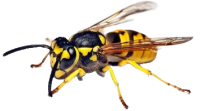
YELLOW JACKETS
Three primary types of yellow jacket removals - ground/bush nesting, in soffits, and inside homes.
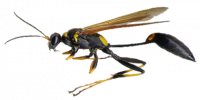
WASPS
There are several types of wasps found on building exteriors - umbrella wasps, mud daubers, paper wasps, etc.
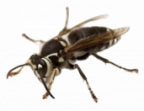
BALD-FACED HORNETS
Usually in a large, enclosed paper nest found in trees, bushes, or on the side of buildings.
Yellow Jackets are true wasps. They are the same size and relative shape of a honey bee and are often confused with honey bees. Nevertheless, they are not a bee and have completely different social behaviors. There are also several ubiquitous varieties each with its own temperament. We often find them in three types of situations starting in mid-July and peaking in mid-September. Each situation requires a different type of removal. We do not try to save these wasps. They will not survive a removal.
GROUND
PROBLEM: These yellow jackets are most often responsible for homeowner stings. The ground nesting variety can be extremely aggressive once provoked.
SOLUTION: They can burrow deep (3' or more) but typically they are found within 12" below the surface, often times under the roots of a bush or behind a stone garden retaining wall. Digging up the nest and spraying them during the process is the most typical method of removal. Caution tape is often used if the location is near a front yard sidewalk. Notifying neighbors within a 50 foot radius of the removal is recommended.
SOFFIT/WALL
PROBLEM: Some yellow jackets will nest in a soffit or home wall.
SOLUTION: The nest must be located either visually or with an infrared heat camera. Once located, the first action should be to physically remove the nest. If that is not possible, then a powder should be applied to foraging yellow jackets as they enter and exit. The tech should wait for this powder to start taking effect to be sure they have been able to deliver enough into the nest to kill the entire colony.
LATE FALL
PROBLEM: A yellow jacket nest will not survive the winter. They are carnivores and perish from lack of food, not the cold. Nevertheless, to survive as a species they produce copious numbers of virgin queens in late fall - as many as 1,000 to 1,500 per nest. These queens are fed a very rich and nutritious diet during development to assure they have plenty of body fat to survive the winter. The virgins will exit the nest before winter and mate. After mating, they burrow into the ground cover with leaf litter to hibernate until spring. Those that survive will come out of hibernation to start a new colony.
Weather plays a large part in determining if all the virgins get mated and are able to burrow into the ground. Often times with so many queens emerging in late fall, if we have an early cold snap that persists for any length of time, these new queens will not have a chance to mate or hibernate in the ground. In that case, they will stay in the nest or near it within the house and hibernate there until spring. The home is much warmer and often confuses these queens. They may try to enter the warm home all winter thinking it is spring time.
SOLUTION: In late fall it is necessary for the entire nest to be removed. It may require the removal of dry wall or soffits to access the nest.
There are many varieties of wasps that will nest on the exterior of a home or building. The typical varieties will be umbrella wasps, mud daubers, or paper wasps. Most will build a small nest or multiple small nests under soffits, soffit peaks, window sills, porch light sockets, or other minimally protected areas.
EXTERIOR
PROBLEM: These nests can be seen attached to a building exterior. They are typically accessible with a step ladder or extension ladder.
SOLUTION: Spraying them with a foaming spray and removing the nest is the most used method of removal.
INTERIOR
PROBLEM: Some wasps, like the mud dauber, will find an opening in areas like a window sill or stone/brick wall. They pose no stinging threat, nor will they damage a home.
SOLUTION: There is no need to kill these wasps. Filling in the opening is usually the method employed to make them leave the home area.
While called Bald-Faced Hornets, they are true wasps. Much caution should be used when handling these wasps. Their sting is mighty and they can spray venom into a tech's eyes. Safety glasses must be worn, as well as a good bee suit.
HANGING NESTS
PROBLEM: This nest is easily identified. Depending on the time of year, this nest can be rather large. It is a gray paper nest with an upside-down teardrop shape, a bit larger than a football. It can be found hanging from a tree branch, in bushes, or on the side of a home at the peak of a gable. Occasionally, it will be higher up in a tree than is reachable by ladder.
SOLUTION: Spraying them with a foaming spray, bagging it up, and removing the nest is the most reliable method of removal. A powder should be applied to the leaves and branches where the nest was located to eradicate the returning foragers.
